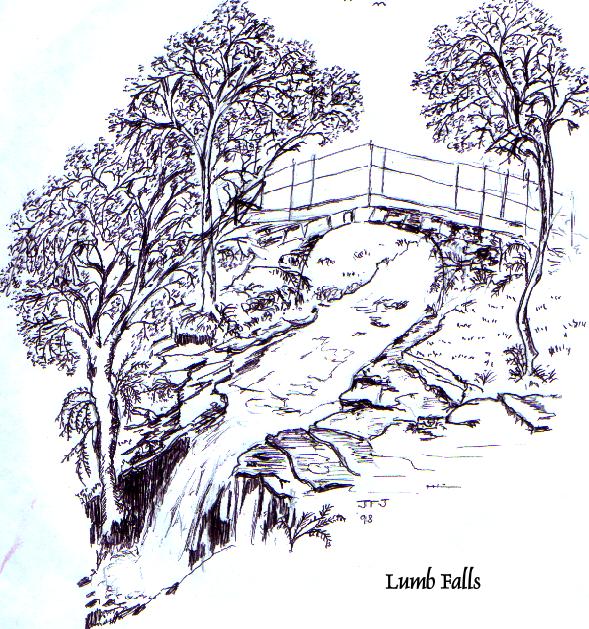Beyond the cottages a path, (The Pennine Way) bears left down to the footbridges over Graining Water, and beyond, after ascending the opposite side of the ravine, bears sharply right, following a wall along the edge of 'The Ridge', finally arriving on the bends of the Widdop road at Blake Dean, near the 'Meeting of the Waters', a popular spot for picnickers.
At the side of the road, sandwiched between hairpin bends once stood the Blake Dean Chapel, and although the chapel was demolished in 1971 the graveyard and some cottages that once served as a Sunday School still remain. The chapel was built in 1823. It was famed at one time for its American Organ.
After crossing the footbridge over the Alcomden Water, the path ascends steps opposite, climbing out of the valley towards New Laithe. En route we encounter the remains of the old railway line which was built to serve the reservoir construction site in Walshaw Dean. Here is a fascinating story. The Walshaw Dean Reservoirs were constructed between 1900 and 1913 and were the work of Enoch Tempest, who died rather tragically after it was discovered that his dams were leaking! (It was later discovered that the leaks were not due to any faults in Tempests constructional techniques). A base camp for the construction work was set up at White Hill Nook near Heptonstall, and was known locally as 'Dawson City'. From there the railway brought out men and materials to the worksite in Walshaw Dean. During the public works some fifteen locomotives were used on the line, all of them having to be hauled up from Hebden Bridge to Dawson City by teams of up to sixteen draught horses - a formidable task! Just below where our path to New Laithe crosses over the site of the old line may be seen the foundations of the huge trestle bridge which carried the railway over the ravine. This was made of pitch pine and was 700 feet long and 105 feet above the stream, a considerable structure. During the peak of the works there was a continual traffic. 'Paddy Mails'carrying men and materials left Dawson City at 5.30,5.40 and 5.50 in the morning. The fifteen workmen's 'coaches' were former Liverpool horse drawn tramcars bearing old destination placards like 'Lime Street' or 'Fazakerley'. Some of these trams were used as navvies shacks up on the construction site. In May 1902 the workforce consisted of 445 men. Looking at the lonely scene today it is hard to imagine such bustling activity, and, as at the ruin up at Gorple, one feels haunted by the shades of vanished people. A little further up towards New Laithe the line of an old tramway is crossed, although it is so indistinct as to be hardly noticeable. This route ran along the eastern side of Walshaw Dean through Hardcastle Crags Woods to New Bridge. It was built in 1872 to supply the construction site at Widdop Reservoir. This was a horse drawn tramway, and represents an earlier period of reservoir works.
Just before arriving at a wooden pedestrian gate in a fence (walls and stone gateway behind) at the start of woodland, bear left, following a path over open moorland which ascends to the barn at New Laithe. At New Laithe pass through the pedestrian gate and follow the farm road past New Hey to Walshaw. Along this road are fine views back to the Packhorse and the Gorple Reservoirs and fine views over the wooded ravine of Hardcastle Crags below. Ahead Walshaw nestles on its hillside, the high edge of Shackleton Moor commanding its rear. In the distance on the right, at the far side of the Calder Valley, Stoodley Pike Monument comes into view.
This folly was built in 1814 to commemorate the Surrender of Paris in the Napoleonic Wars. It collapsed in 1854 and was rebuilt in 1856. Legend has it that its collapse foretells the start of another war or natural calamity. Walshaw is an interesting name. Our English forebears came here and called the native British 'aliens' in their own land - 'Walsh' or the better known 'Welsh' being simply the English word for 'foreigner'. No doubt Walshaw was an isolated Celtic farming community surviving in what had become a largely Anglian/Viking area. When did the last 'Walsh' men live at Walshaw? The Middle Ages, or maybe even down to the Tudor period. These British 'pockets' lasted far longer than we might think.
From Walshaw we head for Shackleton Moor. Ignore the track which climbs towards Horodiddle, just past a house on the left. Instead take the second track on the left, signed 'public footpath', passing through a farm gate. A track, muddy if there is livestock about, passes between walls, and after passing a barn bears left, descending slightly to a small bridge over the upper reaches of Rowshaw Clough. Pass through a gate to open moorland/rough pasture (lots of sheep here) and follow a wall on the left which winds around the hillside just below the edge of Shackleton Moor. At the top of the slope the path passes through a gate on the left then continues onwards along the other side of the wall. (Now on the right). Soon a gate is reached (right) and a grassy track descends in a straight line down the hillside, passing behind the derelict farm at Coppy. This track ends to the right of a derelict three storeyed farmhouse, where it meets the old route from Heptonstall to Haworth coming up from Midge Hole. Turn right through a red iron gate. From here there are fine views down Crimsworth Dean with Heptonstall Church perched on the wooded hill beyond. About a hundred yards along this track turn sharp left, down a track which leads past a ruined farm immediately below. From here a narrow paved track descends between walls to the waterfall at Lumb Hole. Cross the bridge over the waterfall and bear right, passing over a small tributary stream bridged with slabs. Just beyond this, a fine, paved packhorse 'causey' ascends left between walls. This route was overgrown and was restored in 1983 by Pennine Heritage. The track leads through a gate to a metalled road, follow it to the right, passing the farmhouse of Gib on the hillside below. Midway between Gib and the next building along, a track comes in from the right. On the left hand side of the road, just opposite the exit to this track are three gates set back from the road. Pass through the middle one and follow the old packhorse route of Limers gate, which ascends the pasture in a boggy gully, before passing through a gate onto the open moor. Follow the route, (indistinct at times) up the moor to the A6033 Keighley/Hebden Bridge Road. Turn left up the main road passing a boundary wall with open moorland on the right. A few yards further on, opposite a rough layby where you can get a hamburger or an ice cream if you are lucky enough to be there on the right day, a rough path, indistinct in parts, climbs up the open moor, bearing gradually right over rocks to Naze End. The route continues onwards following a line of cairns to the triangulation pillar on High Brown Knoll (1353).
Previous Page
Next Page





